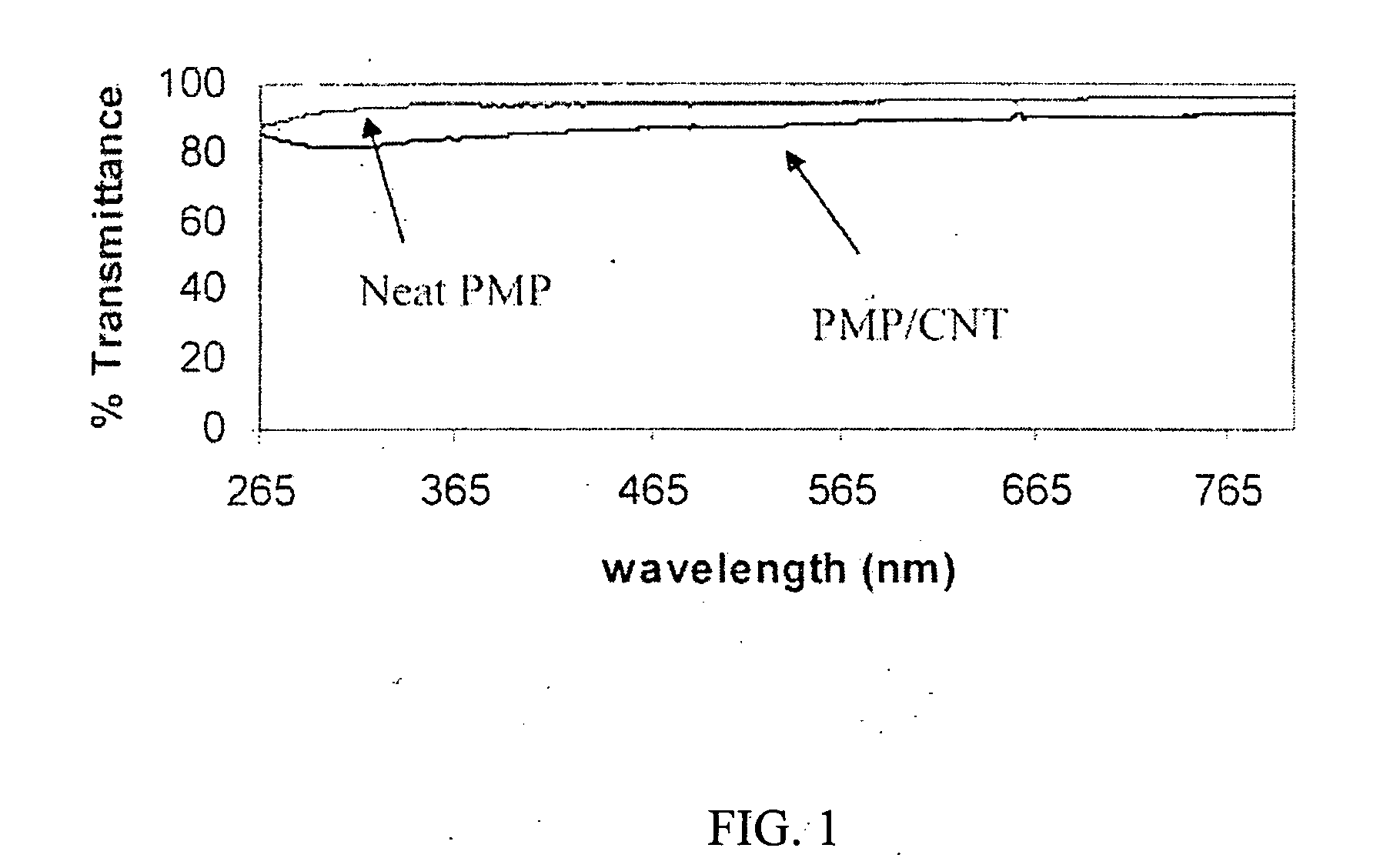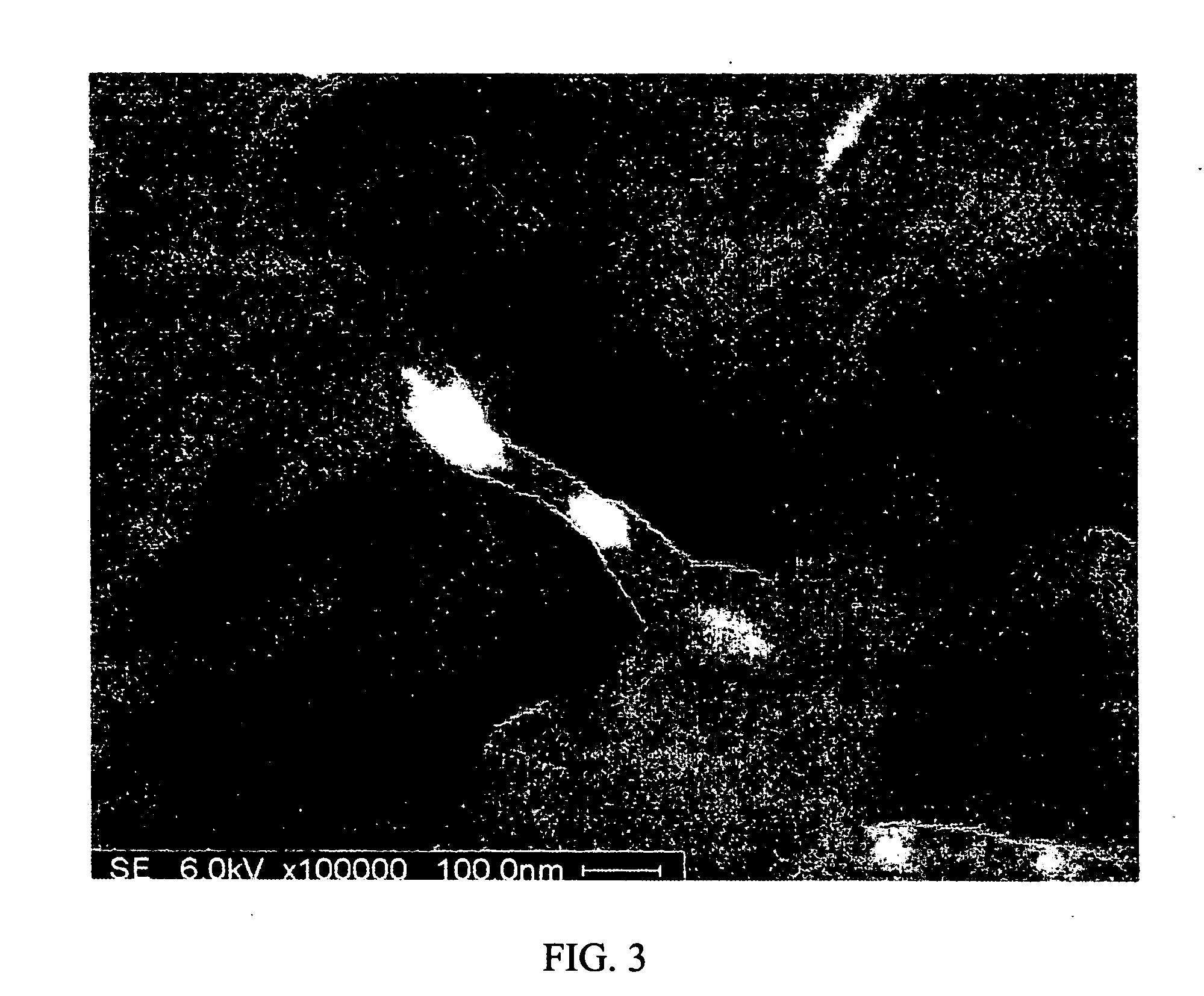Polymer/carbon nanotube composites, methods of use and methods of synthesis thereof
a carbon nanotube and composite technology, applied in the field of optoelectronics, can solve the problem that the use of pe is limited to low temperature applications, and achieve the effect of improving optical properties and maintaining transparency
- Summary
- Abstract
- Description
- Claims
- Application Information
AI Technical Summary
Benefits of technology
Problems solved by technology
Method used
Image
Examples
example 1
Single-Walled Carbon Nanotube Preparation
[0059] Raw laser ablation material provided by NASA Johnson Space Center was purified as described elsewhere (Liu, J. et al. (1998) “Fullerene Pipes”, Science. 280(5367):1253-1256.). The raw nanotubes were refluxed in 2.6 M nitric acid for approximately 160 hours and then diluted with double distilled water. This solution was then centrifuged (4000 rpm), the solvent mixture decanted, and the sample was again suspended in double distilled water. This step was repeated two more times in order to remove the acid from the nanotubes. Finally, the solution was filtered through a cellulose nitrate filter and died at 60° C. in a vacuum oven to form a buckypaper.
Polymer / Nanotube Composite Synthesis
[0060] Commercial low molecular weight poly (4-methyl-1-pentene) with a measured Tm of 235° C. was dissolved in cyclohexyl chloride at 110° C. to make a 3.5% solution. Laser ablated SWNTs were sonicated in N,N-dimethylformamide (DMF) using a Branson Son...
example 2
Studies Using Commercial PMP as Neat Polymer (No Nanotubes) and in USF Processed PMP / Carbon Nanotube Composites with PE Controls
[0076] PMP is purchased from Phillips; PE is purchased as recommended by NASA. SWCTs are purchased from Carbon Nanotube Technologies Inc. (CNI). Neat PMP, PE and PMP composites are compression molded in a Carver hot press according to sample dimension specified by NASA. The composites are prepared by sonicating SWNT in cyclohexane at temperatures below the boiling point of the solvent. PMP is added (5% polymer to solvent by weight). Nanotube concentrations vary from 0.1 to 10% based on nanotube to polymer weight. Solutions with the lower concentrations of nanotubes are cast into films of various thickness using doctor blades. The films are dried in a vacuum over at 80° C. for 12 hours. These films are stacked and compression molded to yield samples of the appropriate thicknesses required for testing. 10% nanotube solutions are dried under vacuum for 25 hou...
example 3
Studies Using Synthesized PMP and PMP Carbon Nanotube Composites
[0077] The synthesis of neat PMP polymer is a low risk experimental plan; well tested, explicit procedures are at hand (Tait, P. J. T. et al. “Polymerization of 4-Methylpentene-1 with Magnesium-Chloride-Supported Catalysts”, Advances in Polyolefins 309 (R. B. Seymour and T. Cheng, eds. Plenum Press) (1987)). This synthesis involves the use of MgCl2-supported titanium catalyst systems. The reactions are carried out in heptane or toluene solvents. Since PMP is commercially available, the reason for undertaking in-house synthesis is to take advantage of the fact that the synthesis starts out with an ultra low viscosity system, monomer in solvent. Once the in-house synthesis of neat polymer is optimized the synthesis is adapted to include the addition of carbon nanotubes-solvent systems, which have been sonicated prior to addition to the monomer catalyst system. However, carbon nanotubes may interfere with the catalyst sys...
PUM
| Property | Measurement | Unit |
|---|---|---|
| temperature | aaaaa | aaaaa |
| transparent | aaaaa | aaaaa |
| transparent | aaaaa | aaaaa |
Abstract
Description
Claims
Application Information
 Login to View More
Login to View More - R&D
- Intellectual Property
- Life Sciences
- Materials
- Tech Scout
- Unparalleled Data Quality
- Higher Quality Content
- 60% Fewer Hallucinations
Browse by: Latest US Patents, China's latest patents, Technical Efficacy Thesaurus, Application Domain, Technology Topic, Popular Technical Reports.
© 2025 PatSnap. All rights reserved.Legal|Privacy policy|Modern Slavery Act Transparency Statement|Sitemap|About US| Contact US: help@patsnap.com



